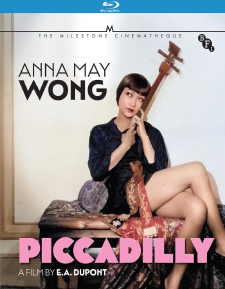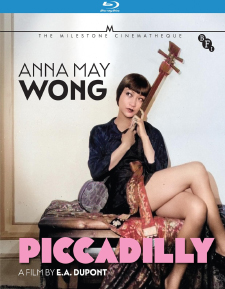Piccadilly (Blu-ray Review)

Director
E.A. DupontRelease Date(s)
1929 (September 26, 2023)Studio(s)
British International Pictures (Milestone Films/Kino Lorber)- Film/Program Grade: A
- Video Grade: A-
- Audio Grade: A
- Extras Grade: A
Review
One of the great masters of silent cinema, E.A. Dupont is largely forgotten today. Consider this great irony: in all likelihood, the Dupont film most widely seen in the United States nowadays is The Neanderthal Man (1953), a low-budget Jekyll & Hyde sci-fi tale with all of the ineptitude of Ed Wood’s infamous films but with none—Let me repeat that, none—of the charm of Wood’s goofy films.
A quarter-century earlier, however, Dupont was an acclaimed, much sought-after filmmaker and his movies were as vibrant and intelligent as Neanderthal is inert and moronic. Born in Germany, he made films there but also sporadically in Great Britain and the United States. Being Jewish, Dupont fled Germany arriving in the U.S. in 1933, but could only find work directing low-budget programmers beneath his abilities. Frustrated, he gave up directing and became a talent agent, but returned to directing and screenwriting in the early-‘50s, even becoming involved in early television, but his later films were even worse than his ‘30s programmers. He directed his last theatrical feature, Return to Treasure Island, in 1954 and died two years later, at 66.
Dupont is remembered by film historians chiefly for two features: Variety (1925), made in Germany and photographed by the great Karl Freund; and Piccadilly (1929), shot in Britain as a silent film just as talkies were taking over. Great Britain was well behind other European countries in their development of the art of silent cinema and, stylistically, Piccadilly looks more like a German silent than a British one.
The picture is visually arresting from its opening moments: in London’s famous Piccadilly Circus, the main titles appear on signage on double-decker buses as all of London seems to be descending upon the famous Piccadilly Club, a restaurant and nightclub. Packing ‘em in are dance partners Mabel Greenfield (Gilda Gray) and Victor Smiles (Cyril Ritchard). Suave Victor is the real star of the two, but both she and the club’s owner, Valentine Wilmot (Jameson Thomas), also her lover, are dismissive of Victor’s popular appeal.
During a performance, a drunk and disruptive diner (Charles Laughton!) loudly complains about a dirty plate. Wilmot investigates, and in the scullery finds the dishwashers distracted by fellow dishwasher Shosho’s (Anna May Wong) spirited dancing. He fires her, and not long after, Victor gives notice, he planning to try his luck on Broadway.
Victor’s departure proves disastrous for the Piccadilly Club, and with business dropping precipitously, Wilmot has the idea of rehiring Shosho, with whom he had a sexual tryst, to perform a seductive Chinese dance solo. Mabel, naturally, considers the idea ludicrous, but then Shosho proves a sensation. Further, Mabel becomes jealous of the obvious sexual attraction Wilmot has for the manipulative Shosho, while Shosho’s Chinese—but Cockney-accented, according to the intertitles—boyfriend, Jim (King Hou Chang), becomes increasingly jealous.
Piccadilly is opulent, adult, and visually kinetic with much camera movement, so much so there are relatively few intertitles—not many are needed. The camera dollies frequently. In one scene, for instance, Wilmot goes to an address in Limehouse Shosho recommends to buy her dance costume. The camera follows him as he makes his way through the labyrinthine building. At one point, Dupont even bolts the camera to a door, so that as it’s slowly opened the camera moves in tandem. The nightclub sets are unusually lavish for a late 1920s British film, and the integration between backlot exterior recreations of Piccadilly Circus and real locations is more or less imperceptible.
Last year, Kino released a boxed of Anna May Wong sound features made by Paramount in the late 1930s. Those films were interesting but also revealed Wong as a limited actress in talking pictures, and by that point she was middle-aged and rather dowdy. In Piccadilly, however, Wong makes a very strong impression, her petite figure, dark eyes and three-level bob hairstyle (a la Louise Brooks) is a striking contrast to Gilda Gray’s alabaster fleshiness, the beauty standard of the time. Wong notably avoided racial stereotypes in her film work, and her sexual relationships with Wilmot and Jim are progressively depicted. Indeed, I’d bet Piccadilly was a major influence for Francis Ford Coppola, whose film The Cotton Club (1984) has much the same look and explores many of the same themes.
Initially released as a silent in February 1929, Piccadilly was reissued later that year with music and sound effects, along with an added one-reel sound prologue that has little to do with the main plot. Milestone’s Blu-ray includes the prologue as an extra feature but, perversely, it’s stretched to 16:9 widescreen for no good reason and is in relatively poor condition. The film, on the other hand, which is tinted sepia and remastered by the BFI National Archive, mostly looks great and without the prologue has a running time of 109 minutes, and it’s run at the proper speed. There are a few missing frames here and there and the quality of the film elements change subtly from reel to reel, but generally it’s an impressive transfer. The disc is Region “A” encoded.
The original music/effects track is not included. In its place, perhaps to secure copyright protection, is a new original score by dramatist and composer Neil Brand. My personal preference is that original music/effects tracks should be used when available; when not available new scores, I feel, work better with 1920s-period appropriate music and orchestrations. Brand’s score is to my tastes much too modern and overly-emphatic at times, competing with the images onscreen instead of working in harmony with them.
Extras begin with a fine, thorough audio commentary track by Farran Smith Nehme, one of the best film historians doing commentaries today. Neil Brand discusses his score for Piccadilly in one featurette, while another is a panel discussion about Piccadilly recorded at the San Francisco Asian-American Film Festival, moderated by B. Ruby Rich, author of Dangerous to Know: The Career and Legacy of Anna May Wong.
Piccadilly is one of those silent features that surprises modern audiences with its visual vitality and intelligent handling of adult themes of sexuality and race. Highly Recommended.
- Stuart Galbraith IV

